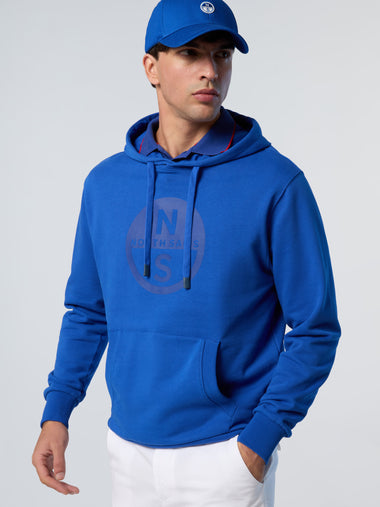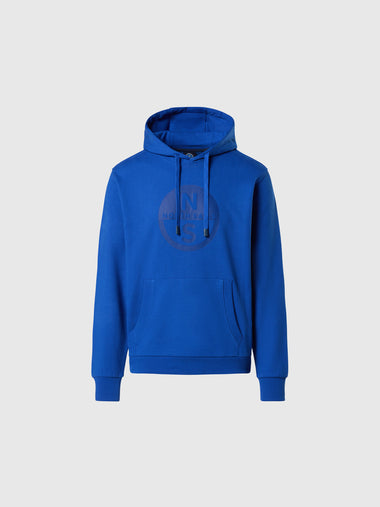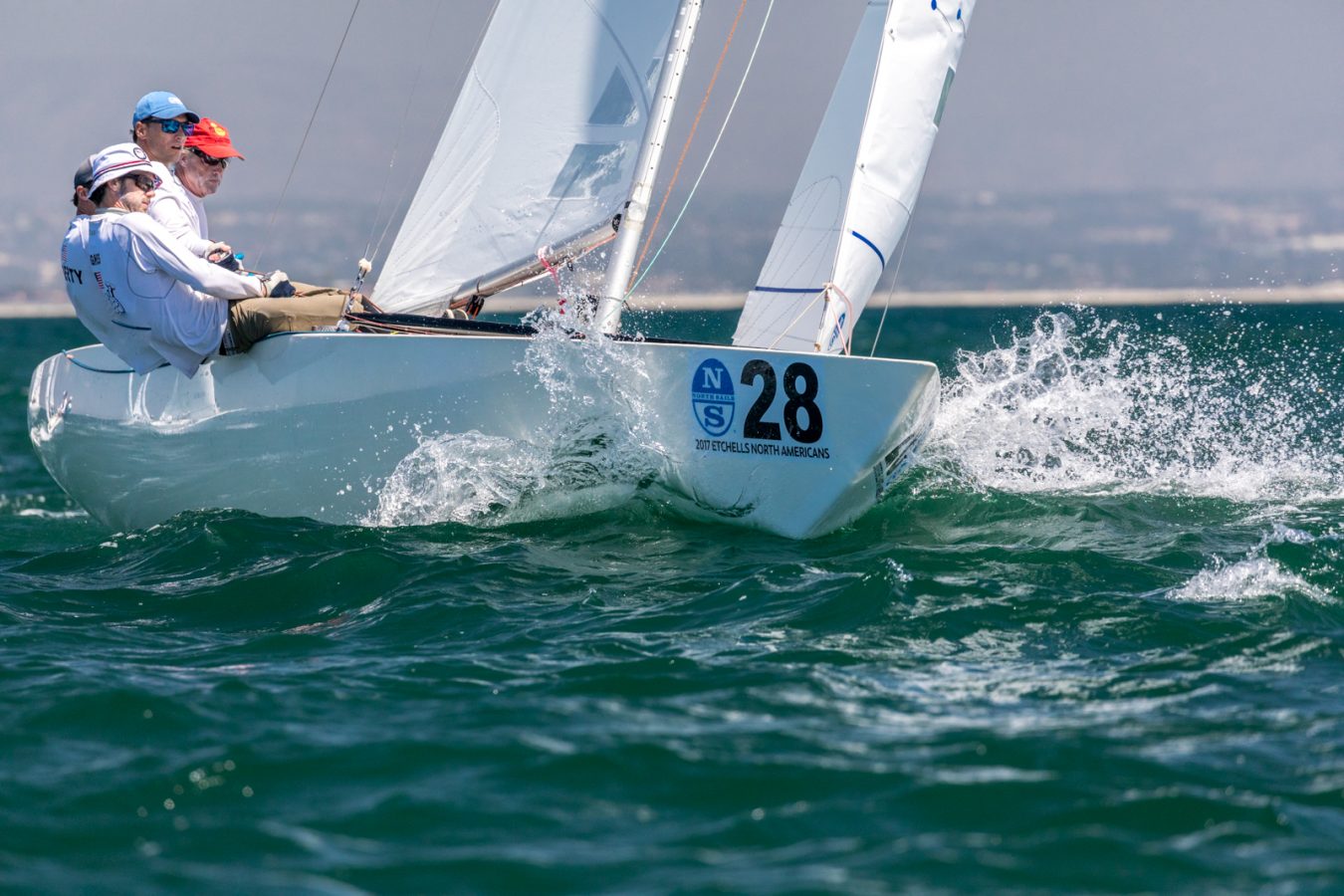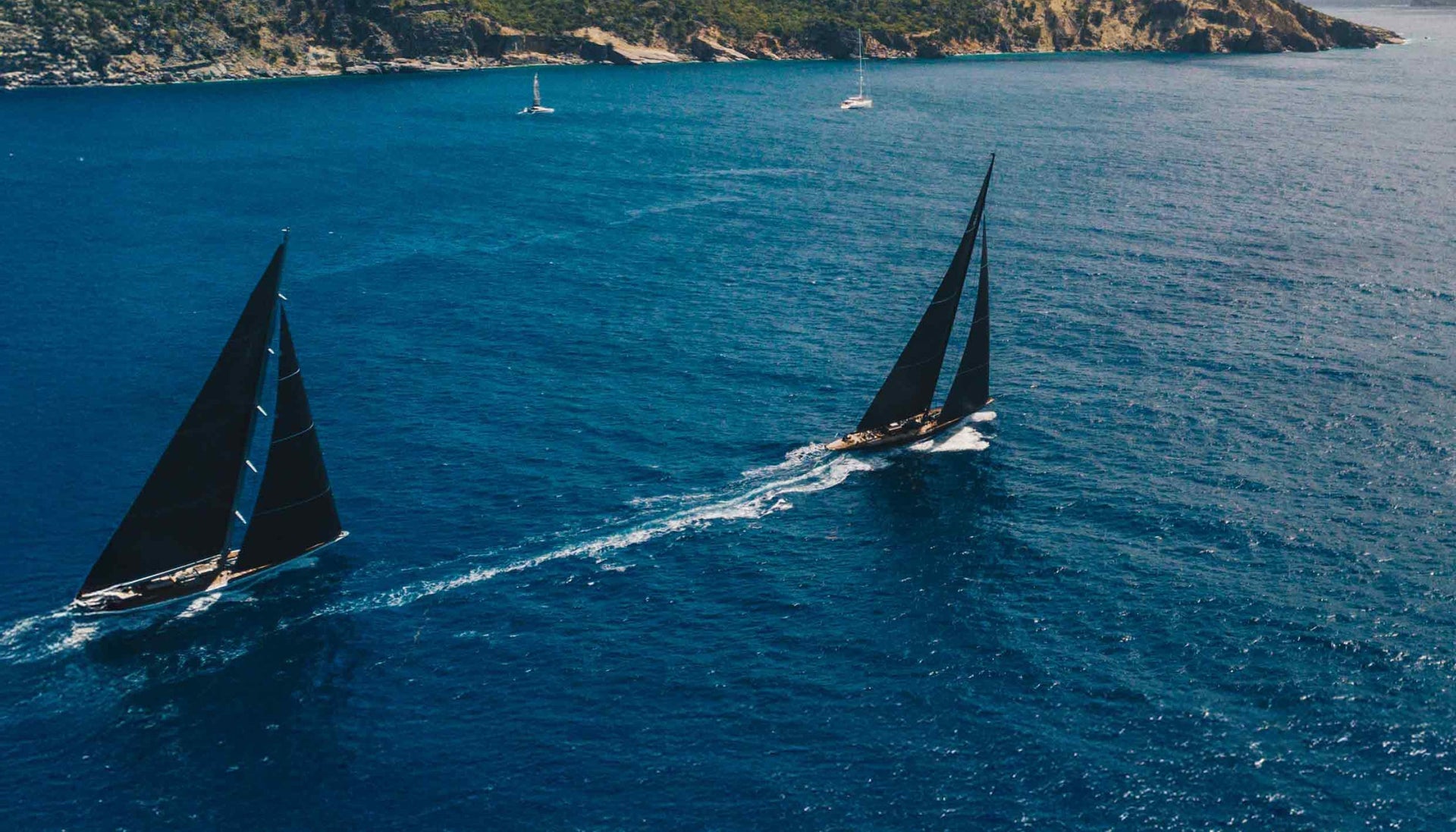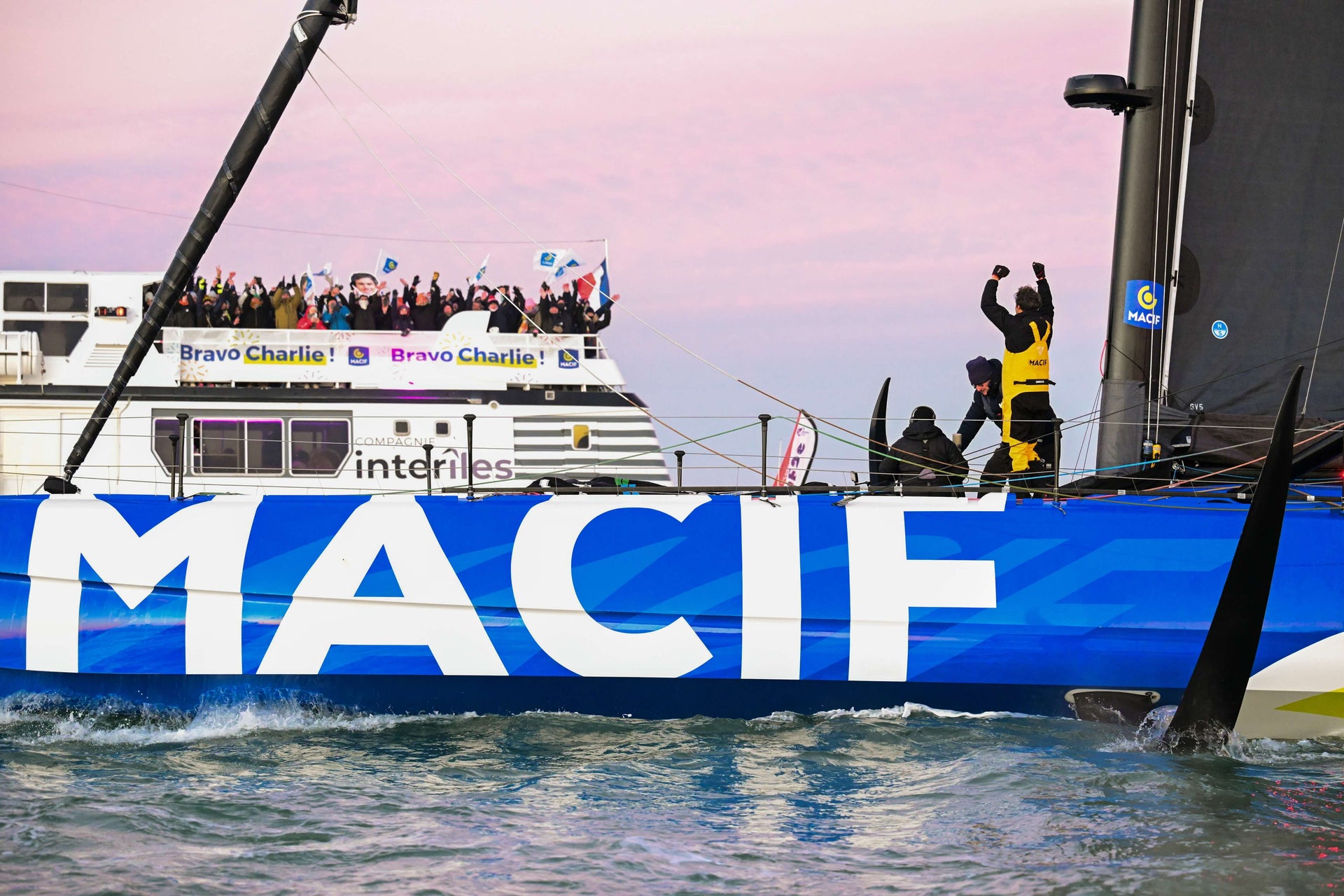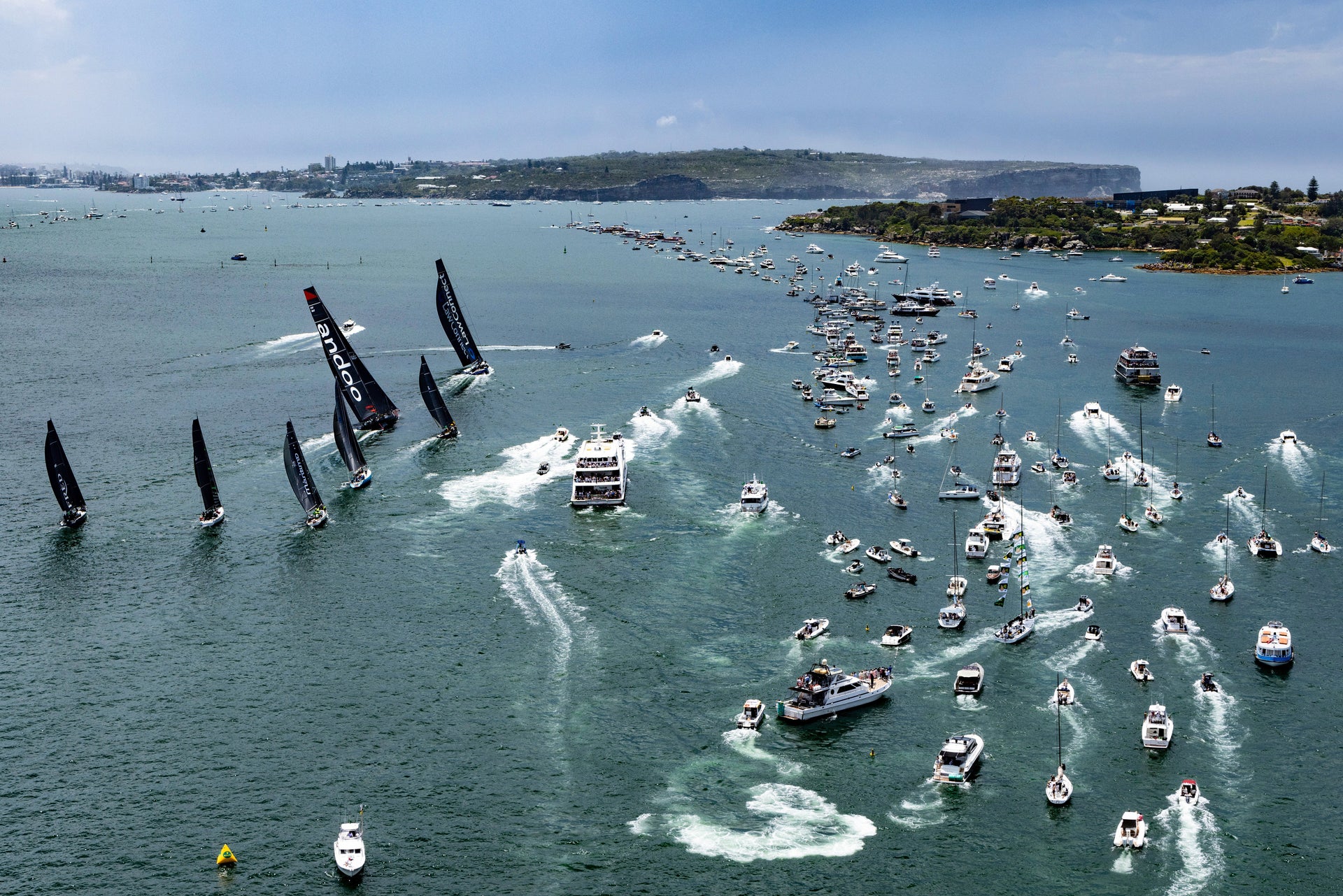THE TACTICIAN ROLE: INTERVIEW WITH MICHAEL MENNINGER
THE TACTICIAN ROLE
Michael Menninger, tactician on SCIMITAR, 2017 World Champion and 4-time Etchells Winter Series winner

Michael Menninger is on a roll. In September of last year the young professional sailor and tactician won the Etchells Worlds in San Francisco with Steve Benjamin. Just a couple of weeks ago Michael and SCIMITAR team wrapped up an overall win of 2017-2018 Etchells Biscayne Bay series, the de facto winter championship for the class. Using North Sails at all these events their team has been truly dominant. Chris Snow from North One Design caught up with Michael to get some insights sailing for one of the worlds best.
Would you say you’re kind of like the quarterback in a way for the team?
A little bit. I mean I’m super lucky to sail with someone like Benj, who has so much experience and knowledge already. He is the quarterback in a way because he does all the organization behind the scenes. Sailing is seemingly always on his mind, and he’s always thinking of ways to improve the team, sails, parts, etc.
He is also the best driver I’ve ever sailed with because he’s not only very skilled but also very receptive and trusting with all the crew. He never dictates or tells us what to do. He is always really quiet and making sure that he is driving to the best of his ability, and then listening to us on where to go and what to do.
During regattas, I guess you could say the football gets passed, and I take on the role of the the quarterback. I just try and make sure that everyone is rested, calm, and ready to race.
Before the start, what’s the discussion on board like? What kind of things are you guys talking about together before the racing starts?
We monitor a few things: the geometry of the race course, as well as the wind strength and how our rig tune, sail and batten selection matches up with the conditions. We also closely monitor our wind forecasts to see how they are matching up with our observations, and it can help us guess what we expect to see next.
In your role as tactician, how do you manage the last couple critical minutes before the start? What type of information are you giving to the team and what are you getting from them?
This is, for sure, the biggest moment in the whole race. I come up with a general plan of where to start. Sometimes, it’s very specific and sometimes it isn’t, but it’s nice to have some sort of plan. A main priority for me is just to stay clear of any big packs and making sure we keep our destiny in our own hands. I find if you have a very specific plan, sometimes it will take you into a crowded situation and then you have greater odds of getting mixed up with another boat or two and not being able to execute on the important things, like hitting the line with speed. That being said, our top priority is to always be in our own water and do what we can to control the boats around us. So once we get into a comfortable place on the line, it’s all about time and distance and managing our hole from that point forward.
What I’m doing at this point is just painting a picture of what we will do next, and take in information such as time, and distance to the line. I’m basically trying to keep us in relatively low-risk situations from 2:00 – 1:00 to go to the start.
I think it’s a really big advantage to have four people on the boat because we have more eyes. We have someone spotting for poachers and hookers. A poacher is someone that is coming in on port and can potentially tack to leeward of you and take up your hole to leeward. And a hooker is someone who is reaching down the line behind you on starboard who is going faster through the water than you and can potentially hook you and control you.
Someone is calling the time, and in some cases, we put Ian on the bow so they can monitor our line sight. If we’re in the middle of the line, it’s nearly impossible to judge how far away you are, and it’s really helpful to have someone on the bow telling us how many boat lengths we have. Given all this information, I dictate which mode we should be in and I work with Benj and the jib trimmer on what needs to be done in those final seconds. I am the voice on the boat so the communication at this stage needs to be clear. If we are controlling the boats around us, the goal is to hit the line at speed at the gun.
It sounds like you would rather start in an uncongested area versus completely at the favored end.
Yea most of the time. It’s so hard to come back in this fleet, if you start in 30th, it is really unlikely that you’re gonna get back to the top eight. So just being able to start and go straight for longer than most, and pick the next best decision and try to get on the next shift, may get you into 15th place right away. Staying clear, keeping our options open and making sure we can pass boats on every leg and not start out at 30th or 40th, is a big priority.
In such a tight fleet there are many times upwind and crossing situations where you have to decide whether or not to cross-tack or allow another boat to cross even though you have right-of-way. How do you typically make these decisions?
The two biggest things that I monitor are where is the max pressure on the course and if we are lifted or headed. Knowing those two things will help you make a lot of good decisions. Sometimes I will sit in a compromised lane for a long time just to stay on the lifted tack, or if I know it will bring me into better pressure or the next shift sooner. I try my best to be patient, but if you see something that you are confident in you should act immediately such as sailing to the pressure.
Ian is kind of my eyes for macro pressure. Focusing on boat-speed, staying in mode with Benj, and trimming the main keeps me pretty busy so having another set of eyes looking forward is key. I rely on the guys up forward with just keeping me honest where the best pressure is. I think you have to be ready to take some transoms in order to stay in the best pressure. If you can do that you will pass all the boats that are hoping something will come their way even if they are sailing away from the pressure. Don’t be hopeful.
Is Ian the second person back?
Yes, he’s the second person back. Previously we had Dave on the jib and now we have Johnny on the jib with Ian just behind. Ian is pretty much just hiking upwind so he has the time to keep his head out of the boat. The jib trimmer is also busy trying to adjust the jib and rig so we can keep the boat at max power. We have the jib trimmer calling micro pressure, counting down the puffs. That’s really helpful for me because there is a lot of different controls to play once a puff hits you (the traveler, the mainsheet, the cunningham, the backstay). Ideally, finding out how strong a puff is going hit us and for how long it gives me time to change the mainsail as the puff is actually hitting us instead of after.
The last third or quarter of the first beat is critical. The boats are still close together and getting around the top mark in good shape can make or break your race. How do you handle this part of the race? Do you have any pointers on that?
I think it goes back to are lifted or are you in the best pressure. You may think that getting out to an edge for clean air and a clean rounding may be best, but if you are sailing away from the best pressure, then that’s obviously no good. It’s pretty tough. You have to imagine the race course without any other boats and ask yourself, what would you do if you were out there alone? If there’s more pressure on the left, you have to go there. You have to spend a tack to go to that pressure and then do your best from that point on.
On the flip side of that, if you have 20 boats going to a single puff, you definitely don’t want to sail behind them all. You want to make sure you are leading them back to the next shift or the next layline. If there’s a puff on the left and there are literally 20 boats in that puff that are taking it back, I don’t think you really want to take all the transoms just to get in that puff because you’ll still be behind them. In that case, you really want to lay up underneath, see if you can get a little bit of the puff on the edge, and be in a position to where, once that puff goes away, the people that are a little bit compromised out of that 20 boat pack are going to be slowly pushed back behind you.
One last thing is to really avoid the laylines at all costs. Since these boats are so windshift-driven and especially in a place like Miami, where the wind’s oscillating all the time and oscillations can be pretty short, getting out to a layline early means that you’re going to miss the last shift and lose boats.
How do you play the downwinds? How early do you decide which gate mark to go to?
I spend a lot of my time looking behind us, just to make sure that we are in a clear lane. Ian on the bow is also looking back a lot and helping me with the macro pressure. One other thing downwind is overstanding is a massive penalty in these boats. Big penalty both upwind and downwind, really. I’m always trying to lead people back to the middle in most cases unless there is big pressure on the side.
As for the gates, sometimes I leave that decision pretty late. I am open-minded on either gate and it can be really difficult to tell which one is closer. I try to not be overly committed to a gate until I’m really sure of which one is going to be favored, and a huge factor in making that decision is which turn is cleaner. Cleaner means which rounding will get you into clearer air and the clearest water as soon as possible.
For example, let’s just say that the majority of the fleet is on the course right side looking upwind, and as you approach the gates there is a right-hand shift making a left turn, favored. A lot of people may think that making a left turn would be better because of the shift and the mark is further upwind. But if it takes you into 25 spinnakers, and chop from all those boats coming downwind, that’s not really good either. In that particular situation, I’d be taking a good look at the other turn, as it could potentially get me into clear and clean water sooner.
It seems to me if you’re rounding directly behind five boats or so, it’s extremely difficult to get the boat going. It turns into a massive pinch fest, and everyone’s going really slow. If you compound that with a lot of boats coming downwind and giving you bad air and more chop, then that’s so painful. If you can take the other rounding, even though it’s not quite as favored, but you have a little bit more room to breathe, you can get the boat moving quicker, then that’s something to really take into consideration.
Actually, I made this mistake on Sunday of the Midwinters on the very last race. I chose the gate to get some more pressure and the shift but it wasn’t quite as clean and we lost a boat that was way behind us. It was super frustrating because I felt like I made the correct decision at the time based on the wind strength and the shifts.
If you sail in a place like San Diego or San Francisco you really have to make sure that you’re going to be rounding a favored gate. That’s going to take you to a side that’s clearly going to pay. In a place that’s oscillating, making sure your rounding is the clearest, it should be a very high priority as well.
You’re just getting started in your sailing career. Is there anybody that you could credit with influencing you in sailing?
Definitely. My family got me into sailing and have given me the tools to succeed from an early age. In the recent years, there hasn’t really been anyone guiding me per say. Sailing’s a great sport because there are so many amazing things to do. You have America’s Cup, Volvo and offshore racing, high-performance sailing like the Moth fleet, the Olympics, professional one-design sailing. They’re all fantastic and have incredible competition.
I think being guided would be easier if you wanted to do just one thing, such as the Olympics. I feel like for myself and for a lot of other sailors who want to keep their options open, there really isn’t a guidebook or a right thing to do and a wrong thing to do.
For me, I just try my hardest to be the best teammate I can be and help our team win in any way that I can, and see where it takes me. In the last few years, I’d have to say a big thank you to Argyle Campbell who gave me a start in the Etchells fleet. He trusted me to put a team together and that was my first year ever sailing Etchells. We ended up winning the JAG series that year too.
Lastly, a huge thank you to Heidi and Benj for giving me all the opportunity I could hope for. Sailing on one of the best Etchells programs is amazing, and bringing me onboard their TP52 Spooky as a tactician has been a fantastic experience.
It’s all been a fun ride these last two years and it has opened the door to other sailing opportunities which I’m really excited for such as doing tactics on Rio for the TransPac 52 West Coast Series. I’m looking forward to sailing more in the Etchells class and also expanding into other classes as well. It’s all been good.
Michael, thanks so much and we wish you the best of luck in all your upcoming adventures!





